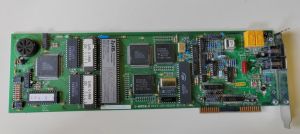ZyXEL U-1496: Difference between revisions
No edit summary |
No edit summary |
||
| Line 3: | Line 3: | ||
| image = Zyxel-u1496b-slika-49835317-68dec34f495e3564082016.jpg | | image = Zyxel-u1496b-slika-49835317-68dec34f495e3564082016.jpg | ||
| caption = A ZyXEL U-1496B modem (c. 1993) | | caption = A ZyXEL U-1496B modem (c. 1993) | ||
| | | 01 Manufacturer = [[ZyXEL Communications]] | ||
| | | 02 Type = External modem | ||
| | | 03 Release date = 1992 | ||
| | | 04 Interfaces = RS-232 serial | ||
| | | 05 Transmission speed = Up to 14.4 kbit/s | ||
| | | 06 Protocols = V.32, V.32bis, V.42, MNP 4/5 | ||
| | | 07 Successor = ZyXEL U-336 series | ||
}} | }} | ||
Revision as of 14:05, 4 October 2025
| ZyXEL U-1496 | |
|---|---|
 A ZyXEL U-1496B modem (c. 1993) | |
| Manufacturer | ZyXEL Communications |
| Type | External modem |
| Release date | 1992 |
| Interfaces | RS-232 serial |
| Transmission speed | Up to 14.4 kbit/s |
| Protocols | V.32, V.32bis, V.42, MNP 4/5 |
| Successor | ZyXEL U-336 series |
The ZyXEL U-1496 was a family of high-speed analog modems produced by ZyXEL Communications in the early 1990s. The model series was notable for its combination of advanced error correction, proprietary high-speed protocols, and robust command-line configurability, making it one of the most respected modems among bulletin board system (BBS) operators and early Internet users.
Overview
Introduced in 1992, the ZyXEL U-1496 supported data transmission rates of up to 14.4 kbit/s in compliance with the V.32bis standard. It also implemented V.42 and MNP error correction, along with ZyXEL’s proprietary “ZyX” high-speed protocol, which enabled transfer rates beyond the official standard when communicating with other ZyXEL modems.[1]
The modem was available in several variants, including:
- U-1496: Base model with V.32bis and standard features.
- U-1496E: Enhanced version supporting fax functionality (Group 3).
- U-1496E+: Added support for leased line operation and voice mode.
- U-1496B: Budget variant, limited to 9600 bit/s.
Technical features
The U-1496 used a full-sized external chassis with LED indicators for line, carrier, and error-correction states. Communication occurred via an RS-232 serial port, and the modem included a comprehensive AT command set compatible with Hayes standards, extended with numerous ZyXEL-specific parameters.
Unique features included:
- ZyX Protocol (ZyX mode): Proprietary data compression and link management for higher throughput when connected to another ZyXEL modem.
- Leased-line capability: Direct point-to-point links without dialing.
- Remote configuration: Sysops could query and modify modem parameters over the line via password-protected access.
- Firmware upgradability: The U-1496’s ROMs could be replaced or updated, a rare feature at the time.
Reception
At launch, the U-1496 was praised for its stability, compatibility, and exceptional build quality. PC Magazine and BYTE both noted its usefulness for professional and semi-professional applications, particularly BBS and corporate dial-up networks.[2]
The U-1496’s proprietary ZyX protocol also made it popular among system operators (sysops) who ran high-traffic bulletin boards, as it provided faster and more reliable file transfers compared to standard protocols.[3]
Successors
The U-1496 line was followed by the **ZyXEL U-336** series in 1995, which introduced 33.6 kbit/s speeds and V.34 compatibility. By the late 1990s, the rise of affordable 56K modems and the transition to broadband rendered the U-1496 obsolete, though it continued to see niche use in amateur radio and industrial telemetry applications.[4]
Legacy
The ZyXEL U-1496 remains a reference point in discussions of early 1990s modem design. Its combination of reliability, configurability, and engineering transparency made it a preferred tool for enthusiasts and professionals alike. Collectors and retrocomputing hobbyists continue to restore and use U-1496 units for vintage network demonstrations and BBS reconstructions.[5]
See also
References
- ↑ "ZyXEL U-1496 Review," PC Magazine, vol. 12, no. 18 (November 1993), pp. 126–129.
- ↑ "High-Speed Modems: Pushing the Analog Limits," BYTE, vol. 18, no. 9 (September 1993), pp. 87–90.
- ↑ R. Nielson, "ZyXEL U-1496E+ Tested," Boardwatch Magazine, vol. 6, no. 2 (February 1994), pp. 32–35.
- ↑ "ZyXEL U-336: Modem Evolution," PC World Taiwan, vol. 9, no. 3 (March 1995), pp. 22–25.
- ↑ J. Lemaire, "The Golden Age of Modems," RetroTech Journal, vol. 2, no. 1 (2018), pp. 44–49.
